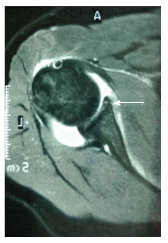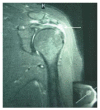Recurrent anterior shoulder instability: Review of the literature and current concepts
- PMID: 25405191
- PMCID: PMC4233422
- DOI: 10.12998/wjcc.v2.i11.676
Recurrent anterior shoulder instability: Review of the literature and current concepts
Abstract
The purpose of this review article is to discuss the clinical spectrum of recurrent traumatic anterior shoulder instability with the current concepts and controversies at the scientific level. Because of increasing participation of people from any age group of the population in sports activities, health care professionals dealing with the care of trauma patients must have a thorough understanding of the anatomy, patho-physiology, risk factors, and management of anterior shoulder instability. The risk factors for recurrent shoulder dislocation are young age, participation in high demand contact sports activities, presence of Hill-Sachs or osseous Bankart lesion, previous history of ipsilateral traumatic dislocation, ipsilateral rotator cuff or deltoid muscle insufficiency, and underlying ligamentous laxity. Achieving the best result for any particular patient depends on the procedure that allows observation of the joint surfaces, provides the anatomical repair, maintains range of motion, and also can be applied with low rates of complications and recurrence. Although various surgical techniques have been described, a consensus does not exist and thus, orthopedic surgeons should follow and try to improve the current evidence-based treatment modalities for the patients.
Keywords: Dislocation; Glenohumeral joint; Recurrent instability; Review; Shoulder.
Figures







References
-
- Hovelius L, Augustini BG, Fredin H, Johansson O, Norlin R, Thorling J. Primary anterior dislocation of the shoulder in young patients. A ten-year prospective study. J Bone Joint Surg Am. 1996;78:1677–1684. - PubMed
-
- Dodson CC, Cordasco FA. Anterior glenohumeral joint dislocations. Orthop Clin North Am. 2008;39:507–518, vii. - PubMed
-
- Kaplan LD, Flanigan DC, Norwig J, Jost P, Bradley J. Prevalence and variance of shoulder injuries in elite collegiate football players. Am J Sports Med. 2005;33:1142–1146. - PubMed
-
- Taylor DC, Krasinski KL. Adolescent shoulder injuries: consensus and controversies. J Bone Joint Surg Am. 2009;91:462–473. - PubMed
-
- Mohtadi NG, Chan DS, Hollinshead RM, Boorman RS, Hiemstra LA, Lo IK, Hannaford HN, Fredine J, Sasyniuk TM, Paolucci EO. A randomized clinical trial comparing open and arthroscopic stabilization for recurrent traumatic anterior shoulder instability: two-year follow-up with disease-specific quality-of-life outcomes. J Bone Joint Surg Am. 2014;96:353–360. - PubMed
Publication types
LinkOut - more resources
Full Text Sources
Other Literature Sources

